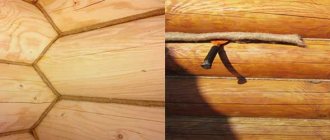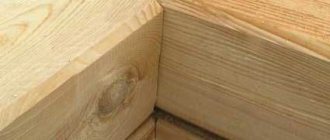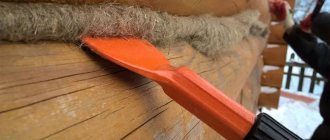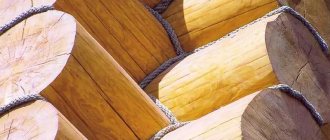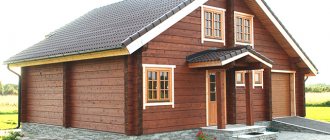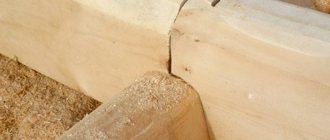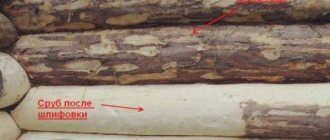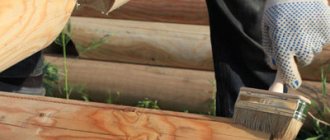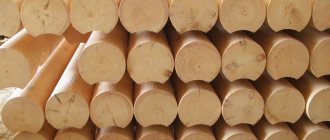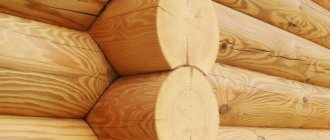Caulking a log house will require time, diligence, the right material and a good tool.
Such work is quite labor-intensive and manual. There are no mechanical devices that would speed up the caulking process and make the work easier. Only with your own hands and nothing else.
It’s not for nothing that in wooden construction there is such a specialization as “caulkers.” A team of several strong men only performs caulking!
Since they perform only this kind of work, they have achieved the highest qualifications in this specialization. If you manage to find such a team, then be sure to use their services, because the caulking will be done quickly and, most importantly, with HIGH QUALITY.
Naturally, the caulking team has a complete set of tools for caulking log cabins for all occasions, depending on:
- material used for sealing log seams
- seam sizes
- type of log wood
- the presence of complex elements (corners, junctions) in the configuration of a wooden building
Tool for caulking a log house
A caulk is a wooden or metal spatula and has a fairly simple design. The simplest versions of the product are easily made from cuttings of birch or pine boards; the thickness of the blade is adjusted to the width of the grooves of the log house.
However, such tools quickly become unusable during operation, so for their manufacture it is necessary to adhere to certain requirements.
Types of tools
Caulks are made of hard wood in the form of spatulas with a handle and a sharpened blade so that you can easily seal joints in timber or logs (photo below).
To carry out insulation work during the construction of a log house, caulking of the basic type or typesetting is used. The dimensions of the main tool vary in length from 150 to 250 mm, width 50 mm and thickness 5 mm. The blade is flat and has a blade.
Stackable caulk is intended mainly for sealing ordinary seams and allows you to freely push the insulation into narrow cracks. Depending on the area to be treated, caulk is divided into large, medium and narrow.
Installation of insulation is done using the “set” method, in which the fiber strands are twisted into a set of loops, after which they are plugged into the cracks.
To process the corners of the log house, a tool with a curved shape is used. Curved caulking allows you to fill uneven gaps and grooves of different sizes, as well as in the corners and curves of the log house. The blade width of the tool is 50-60 mm and 5 mm thick . It is better to use a metal spatula to seal corner joints.
Breakable (wedge-shaped) caulking helps to expand the gaps between the crowns to make it easier to lay the insulating layer . The blade width of the product is 30 mm . The tool is used in hard-to-reach places when processing profiled timber.
The road worker is a caulk with a wide blade of 170 mm and 8-15 mm thick and a longitudinal groove 10 mm deep. Thanks to this design, the insulation fibers can be twisted into a roller when sealing holes using the “stretch” method.
Using the tool helps increase work productivity and more effectively compact the insulation material into the grooves of the timber. In the process of work, a road worker of three sizes is used - for narrow, medium and wide grooves.
metal caulking chisel It is available in several sizes according to the width and thickness of the blade, designed for processing grooves of different sizes.
Along with caulking tools, other tools are also used to install insulation.
Mallet (mushel) is a hammer with a wooden or rubber base, which is used when hammering in insulation. Thanks to the impact load with a mallet, the insulation penetrates deeper into the grooves of the frame.
The hammer is made of hard wood and to increase the strength of the working surface, several metal hoops are put on the tool - from 4 to 6 pieces. The dimensions of the mallet are 10-15 cm in diameter, the length of the handle is 30 cm.
Tool Requirements
- The caulk can be wooden or metal, always with a smooth blade, since the insulation during operation should not cling to the roughness of the blade.
- The performance of a tool with a metal blade is higher than that of a wooden one. However, a blade that is too sharp will cut the grain rather than compact it and leave marks on the wood.
- To make it more convenient to work, the handle of the spatula can be made of corrugated rubber.
- For greater efficiency, it is necessary to use three caulks: two with a wide blade, one with a narrow blade.
Caulking materials
For caulking timber or logs, it is better to use natural insulation materials that have the following characteristics:
- hygroscopicity,
- resistance to temperature changes,
- breathability,
- environmental Safety,
- ease of installation.
Such insulation materials include:
- moss (red and white),
- tow,
- flax wool,
- jute.
Moss
The safest and most practical material with excellent antiseptic properties. It provides reliable protection of wood from rotting and biological damage.
Moss (sphagnum) is a reliable material for sealing crown joints: it allows air to pass through well and quickly absorbs excess moisture, prevents the development of pathogenic microorganisms and fungi, thereby increasing the service life of wood.
Moss is resistant to fire and decay, so it can maintain its performance characteristics for a long time. High cost is the only drawback of this material.
Self-procurement of raw materials will significantly reduce the cost of thermal insulation of a house made of logs or timber.
Before caulking the walls, the pre-prepared moss must have a suitable level of humidity - not be overly dry or moist.
Tow
A practical and safe material that is used for caulking crowns after complete shrinkage of the log house. It is made from hemp, jute and flax fibers.
Sold in compressed bales or rolls. Tow in bales has short and hard fibers, which complicate the process of driving crown joints. High quality tape tow has long, elastic and soft fibers.
This material has low antiseptic properties and is susceptible to high moisture, so it requires additional treatment with protective impregnations or paints.
The high content of brome (coarse flax and hemp waste) leads to rapid wear of tow, so caulking is carried out every 3-4 years.
The main disadvantages of insulation include the difficulty of installation, the unattractive appearance of the treated seams, and a short service life.
Lnovatin
A natural material for caulking wooden houses, which is produced by pressing short flax fiber into strips. Linen wool has high heat-insulating and moisture-resistant characteristics. Such insulation can provide reliable protection of wood from rotting and mold.
Linen batting is used to seal seams between crowns with fixation on metal staples.
Jute
The highest quality and most durable tape insulation for caulking houses made of logs or timber. The material has high heat-saving properties and is not susceptible to rotting and mold. Even with prolonged exposure to moisture, jute fiber remains practically dry.
Jute is used for primary and secondary thermal insulation of a house. It has high strength, wear resistance, elasticity and practicality. It is placed in interventional seams with fixation with staples.
The only drawback of the material is its high cost.
Features of insulation installation
- Insulation of a log house is usually carried out in the warm season: first outside the house, then inside. Direct work on caulking the house is done only after the structure has completely settled and dried. The level of the building upon completion of insulation work increases by 10-12 cm.
- Treatment of seams with insulation begins from the lower crowns. After the entire perimeter of the building has been consistently completed, they move on to the overlying crowns.
- In the process of sealing seams, the “stretch” method is used. To do this, the tow is pulled out and pressed into the gap with a spatula, tightly filling it with the remaining insulation.
- To fill wide grooves, the “set” method is used, for which the tow fibers are folded into a loop and driven into the cracks.
- It is best to select a material for thermal insulation with the same hygroscopicity in order to avoid deformation of the structure. One-sided caulking of a log house can also lead to its distortion.
When building a house, auxiliary tools are often used: electric chisels, chisels, plane blades, axes, etc. Instead of a mallet, a hammer is often used, as a result of which wooden caulks quickly break.
Hard blows from a metal hammer and other similar tools can damage a log wall, especially if the force of the blow is not calculated. Therefore, it is best to use professional tools for insulation work.
The construction market now offers a wide range of metal and wooden products for insulation work. Despite the fact that metal samples are more durable, wooden caulks are more practical to use and cheaper. That’s why craftsmen most often prefer to purchase and use the latter.
The highest quality products are produced by several large companies in our country and abroad, which can be purchased not only in Moscow and St. Petersburg, but also in other regions.
Price
The cost of caulking for insulating a log house will depend on the material from which it is made. It can be metal or wood. Construction of a house from laminated veneer lumber allows the use of only wooden tools. In addition, the price will directly depend on the type of caulk. The most expensive of all types is chisel caulking; at the lowest price you can find narrow caulking. Approximate prices for caulk from different manufacturers
| Manufacturer | A type of caulk | Cost, rub.) |
| "Tool City" | Caulking chisel | From 168 |
| Stacked (main) caulk | From 134 | |
| "Winter House" | Caulking chisel | From 180 |
| Stacked (main) caulk | From 165 | |
| "Caulker" | Caulking chisel | From 170 |
| Stacked (main) caulk | From 155 | |
| "Flax and Jute" | Caulking chisel | From 158 |
| Stacked (main) caulk | From 145 | |
| "DrevCos" | Caulking chisel | From 174 |
| Stacked (main) caulk | From 156 |
The tool for caulking a log house should be chosen carefully. Otherwise, you can not only waste money, but also damage the insulating material and timber.
Selection and use of caulk
To work, you also need a flat caulk. The very name of the instrument speaks for itself. It is used to install insulation using the kit method. This means that the material is twisted into a single thread using a series of loops. The loops are pushed with a tool into the cracks and gaps between logs or beams. Well-known requirements for a blade:
- It is better to use a tool that has a metal main working part. Iron should not bend easily. In this regard, high-quality steel is preferable.
- The handle of the tool should fit well in the hand and be comfortable. Handles made of corrugated rubber or rubber handles have proven themselves to be the best.
- You need to hit the end of the handle with a mallet. The end should be a knob with a cap.
It is better to use a caulk with a blade measuring 100 mm and a thickness of 5 mm.
In addition, other tools are used for caulking a log house. They are presented in a wide range, which allows you to choose a copy that is convenient to use.
Video description
This video describes in detail the methods of caulking log houses:
They try to use wooden tools for caulking log houses. They are softer and do not leave damage on the logs.
It is advisable to caulk the log house from the inside and outside. You need to start from the corners, you need to go from bottom to top, caulking each row to the end. If you work on the walls separately, you can warp the entire building.
You need to start caulking the log house from the bottom rows Source psk.baraholka.com.ru
Features of a wooden instrument
This tool is something like a wooden spatula. It can be made on your own. It may seem that there cannot be any special difficulties. You just need to plan a wooden blade and start insulating it. Slowly tap the instrument with a wooden mallet, sealing the seam with tow.
Some craftsmen even try to use an axe. They just try to stick the tow inside the seam.
Insulation is not an easy process. In ancient times, self-made blades of different widths and sharpness were used to perform it. But this was not entrusted to everyone, but only to a recognized craftsman.
A caulk is a tool that must have the following necessary qualities. It must be made from hardwood. If the material was unsuitable, it lost its qualities after just a couple of meters of sealed seam. The blade could become covered with burrs and become completely unusable.
If the hammer for hammering is made of metal, then the caulk must also have a metal handle.
The purpose of the application is to fill the seam as tightly as possible with insulation. When using low-quality logs in the construction of a log house, it will be necessary to seal fairly wide seams. This circumstance will allow you to fill them out without any extra effort. When finishing a log house with thin logs, you will need to use a metal device.
Using a caulking chisel
A caulking chisel is a metal version of this tool. Today you can buy it in a store without any problems. Branded products are offered by the best manufacturers.
A good quality chisel can also be adapted under certain conditions. It should not be particularly thick and have a blade less than 5 mm thick. A regular chisel is too narrow. They will have to carry out insulation for an unreasonably long time. The process will be speeded up by a 100 mm spatula. It is this device that needs to do the job. This tool is called a caulking tool.
Chisels are used to perform specific operations. They have different lengths and blade thicknesses. It is necessary when sealing seams and grooves of different sizes.
Using caulk with a hammer drill
A caulk with a hammer drill will significantly speed up the progress of work. In this case, the quality will be worse, since there is a high risk of damage to the logs of the log house. The load becomes uncontrollable. This is due to its shock nature. Manual execution requires the master to make only 1 blow per width of the blade of the device.
The insulation is placed at a given depth. Using a hammer drill involves frequent impacts that the worker cannot accurately assess. The insulation is laid unevenly, the seams are insulated poorly.
Mallet for performing insulation
A wooden hammer or mallet is simply necessary when insulating a log house. A good master with experience and significant experience usually has his own large set of mallets of various modifications. It is preferable to use a mallet of the same type of wood as the log house that needs to be caulked. This is not always essential, but it is desirable. Mallet has other names. Some masters call it a mushel, a beater.
A curved caulk will be very useful in this work. In a log house there are a large number of rounded sections, the ends of the logs. This type of caulk has a narrower blade than a flat caulk, its size is 50 mm with the same thickness of the blades of both modifications of the tool.
A road worker is also used. This tool has a fork-shaped appearance. It is necessary for forming rollers in the most convenient way. A road builder is used when caulking a log house using the stretch method. It should have a width of 170 mm. The recess in the road construction must be selected in accordance with the dimensions of the grooves. An experienced master always has at least 3 tools of this type with him. They are used for seams of different sizes.
It is equally important to have a breaking caulk on hand when caulking a log house. It is necessary to widen an excessively narrow groove. The breaking caulk has a wedge-shaped blade, which makes it possible to expand the space. It will have to be filled with material using another device.
Execution of work
Caulking of log houses or beams is a labor-intensive task that is performed entirely by hand. There are no devices that mechanize such work. This process is long and quite difficult; the master performs it only with his own hands.
Caulkers are a special specialty in wood construction. The caulking team consists of several physically resilient and strong men who perform caulking exclusively.
Since these masters are not involved in other types of work, they reach the pinnacle of mastery in their specialization and have the highest qualifications. If possible, you should definitely use the services of such a team, since everything is done quickly and with the highest quality.
It is quite clear that a team of caulkers has at its disposal the entire necessary set of tools to carry out caulking of a log house of any complexity:
- in the presence of any material for sealing the seams of the log house;
- different sizes of seams;
- different types of wood for wooden buildings;
- the need to seal seams in complex elements.
Every stage of work is important. It is impossible to neglect caulking, on which the warmth and comfort of living in the house depends. It is impossible to do without it in wooden construction.
"DrevCos"
Stroitelnaya has been operating in the market for the sale of building materials for more than ten years. The store cooperates only with trusted manufacturers who have the necessary licenses and certificates for the production of tools. The company has several regular customers and a large number of positive reviews.
All products are carefully checked and inspected before they are put up for sale or sent by courier.
Reliable and fast delivery to anywhere in the country is also guaranteed. A close-knit team of workers quickly and efficiently accepts all orders. The store is located at:
Moscow, st. Ugreshskaya, 2с64, metro station Kozhukhovskaya, Technopark "Sintez". Contact by phone.
A tool for caulking a log house.
Doing the work of caulking a log house with your own hands requires diligence, attention, and you can’t do it without a high-quality, reliable tool. Using wooden caulking, the insulation is sealed into the cracks. There are several types of devices for wall insulation.
Basic requirements for the tool.
Shovels and devices for caulking should have a smooth blade so that when the tool is pulled out, the fibrous insulation does not cling to it. Also, the blade should not be too sharp, otherwise, instead of compacting the material into the cracks, it will cut it.
The material for tools for caulking a log house is not always hard wood; it can also be metal.
To carry out the work efficiently, you will need at least 3 caulks.
- With a wide blade – 2 pieces
- With narrow – 1.
- A mallet or beater is also required.
All of the following types of tools are universal and suitable for both filling gaps in timber and caulking a house made of rounded logs.
Types of instruments.
Special blades with sharpened blades and a handle are made from hardwood. This device makes it easy to push material into the cracks.
The most important typesetting spatula has many varieties. There are caulking tools for sealing large surfaces, for very narrow gaps and medium grooves.
The main caulk is approximately 150 to 250 mm long and 50 mm wide.
Mallets, which are designed to hit the shoulder blade, are also made from the same hard wood. Using a mallet, an impact load occurs and the insulation penetrates deeper into the gap. Until the insulation springs back, strike until it rings, as builders call this procedure.
To seal grooves, there is a flat caulk; such products are commercially available with different blade thicknesses, from 5 to 100 mm. You can choose any one that is more suitable for the cracks in your home, or several that will undoubtedly come in handy during work.
Do-it-yourself caulking of a log house is impossible without using a curved spatula for corners and rounded places. Its blade thickness is from 5 to 50 mm.
A blade-shaped caulk designed to widen the grooves is also needed. In places where beams are closely adjacent to each other, very small gaps, you can’t do it without a breaking spatula; it will help push tow or jute there. The width of the tool blade reaches 30 mm.
Tips for performing caulking.
Work on caulking a log house should be carried out in the warm season, only by hand. Work is carried out first outside, only then inside the house. You should start from the lower crown and, walking along the perimeter of the room, rise higher and higher to the last upper crown. Technology must be followed. The insulation material must absorb moisture well and be resistant to environmental influences.
Some craftsmen, mainly private traders, those who are willing to do caulking for money, use a hammer drill. Immediately warn such craftsmen to caulk with their hands.
Using different types of tools, you will no longer wonder about how to properly caulk a log house. With such a large assortment of shovels and beaters, even an inexperienced person in this matter can caulk a house efficiently. Therefore, caulking a log house with your own hands will not cause any difficulties; rather, it will allow the homeowner to gain invaluable experience in the construction business.
"Winter House"
Construction offers to purchase tools for caulking both wholesale and retail. There are several types of tools available, so you can choose the one you need. The company cooperates only with trusted manufacturers; products are inspected and tested for quality before being put up for sale.
Thanks to such precautionary measures, you can purchase caulk at an attractive price and of good quality. To purchase products, you can visit the store or call and place an order with the help of a manager.
Fast and reliable delivery is guaranteed. The store is located at the address: Moscow region, Balashikha, Sovetskaya str., 35. If you have any questions, please contact us by phone.
